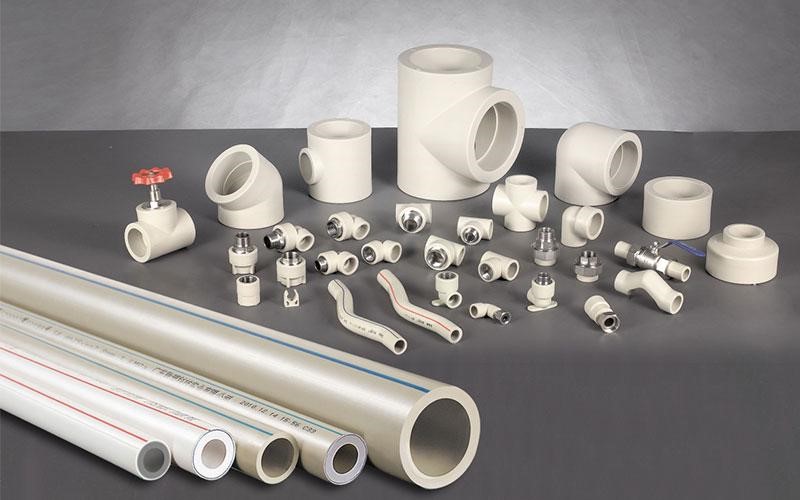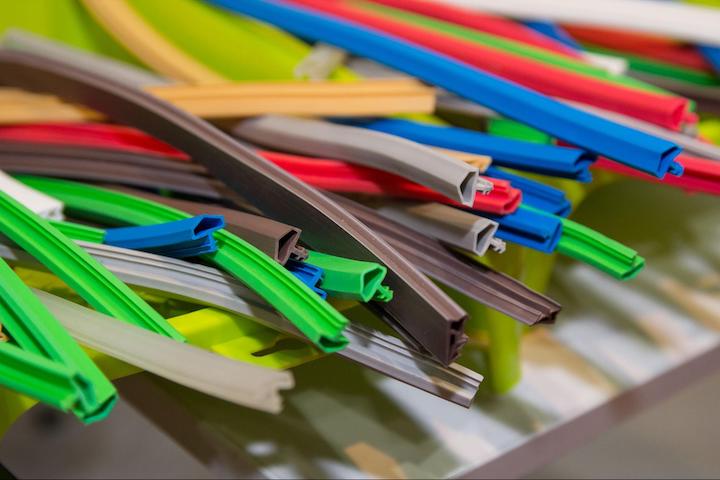Extrusion defects include surface irregularities, dimensional inconsistencies, structural imperfections, material issues, and process-related anomalies.

Surface Defects in Extrusion
Surface defects in extrusion are imperfections that compromise the appearance, functionality, or structural integrity of the extruded product. They can occur due to various factors such as equipment settings, material properties, and processing conditions.
Surface Cracking
Surface cracking, as the name suggests, are visible cracks that appear on the surface of an extruded product. These cracks can degrade the product’s appearance and might lead to structural failures under certain conditions.
- Causes:
- Inadequate material heating, leading to brittle extrusion.
- Rapid cooling, causing material contraction at different rates.
- High extrusion speed can stretch the material beyond its tensile strength.
- Solutions:
- Ensure uniform heating and cooling throughout the process.
- Adjust the extrusion speed to match material properties.
- Regularly check and calibrate equipment to maintain consistent output.
Sharkskin or Melt Fracture
Sharkskin or melt fracture is a defect where the surface of the extruded product appears rough or wavy, resembling the skin of a shark. It impacts both aesthetics and, in some cases, the functionality of the extruded piece.
- Causes:
- High shear rates causing material to stick and slip on die walls.
- Mismatch between material viscosity and extrusion speed.
- Solutions:
- Optimize die design to reduce high shear regions.
- Adjust material formulations or use lubricants to improve flow.
- Modulate extrusion speed and temperature settings.
Explore Sharkskin Defect in-depth on Wikipedia
Die Lines
Die lines are linear imperfections on the surface of an extruded product that run parallel to the direction of extrusion. These lines can affect the product’s appearance and might influence its structural properties.
- Causes:
- Imperfections or debris in the die.
- Uneven flow of material through the die due to temperature variations or inconsistencies in material properties.
- Non-optimal die design, leading to regions of uneven shear.
- Solutions:
- Regular cleaning and inspection of dies to prevent build-up.
- Ensure consistent material feed and temperature control.
- Collaborate with die manufacturers to optimize die design for specific materials and processes.
Dimensional Defects in Extrusion
Dimensional defects are inconsistencies in the extruded product that deviate from the desired measurements or profiles. These imperfections can negatively impact the product’s performance, leading to potential failures in real-world applications.
Size Variations
Size variations are discrepancies in the product’s measurements, where the extruded product may be larger or smaller than the intended dimensions.
- Causes:
- Fluctuations in extrusion speed. For instance, an increase in speed might produce sections that are 5% thinner than desired.
- Inaccurate calibration of the extrusion machine, leading to outputs that deviate by up to 10mm in length.
- Variations in material feed rate, causing sections to be underfilled or overfilled.
- Solutions:
- Implement real-time monitoring systems to detect and adjust for size variations instantly.
- Regularly calibrate equipment to ensure consistent extrusion dimensions.
- Maintain a uniform material feed rate.
Wall Thickness Inconsistencies
Wall thickness inconsistencies are variations in the thickness of the extruded product, especially in hollow products or products with cavities.
- Causes:
- Uneven material flow, causing certain sections to be thicker, with differences reaching up to 3mm.
- Temperature fluctuations leading to material expansion or contraction.
- Non-uniform cooling, where one side cools faster than the other, resulting in varying thicknesses.
- Solutions:
- Use high-quality dies designed for uniform flow distribution.
- Maintain a consistent temperature profile throughout the extrusion process.
- Employ cooling systems that provide uniform cooling to the extruded product.
Bowing or Warping
Bowing or warping refers to the bending or distortion of the extruded product, causing it to deviate from its intended straight or flat profile.
- Causes:
- Uneven cooling rates can cause one side to contract faster, leading to a curvature of up to 15 degrees over a meter-long product.
- Inherent stresses in the material due to previous processing or molecular orientation.
- Mismatch in material formulations, leading to internal tensions when cooled.
- Solutions:
- Implement uniform cooling systems.
- Preheat material adequately to relieve inherent stresses.
- Adjust material formulations to ensure compatibility and reduce internal stresses.
Structural Defects in Extrusion
Structural defects in extrusion pertain to the internal composition and integrity of the extruded product. While some of these defects might not be immediately visible on the product’s surface, they can significantly compromise the material’s strength, durability, and overall performance.
Splay or Silver Streaks
Splay, commonly known as silver streaks, manifests as shiny, silvery lines or patches on the product’s surface, which indicate areas of localized degradation.
- Causes:
- Excessive moisture in the material, which can create steam during the extrusion, leading to streaks.
- High shear rates causing localized overheating and degradation.
- Presence of low molecular weight components or contaminants that vaporize during extrusion.
- Solutions:
- Pre-dry materials to reduce moisture content below 0.02%.
- Modify screw and die designs to minimize high shear areas.
- Implement stringent material quality checks to ensure purity.
More on Splay and Silver Streaks in Extrusion
Voids or Air Bubbles
Voids or air bubbles are empty spaces or pockets within the extruded product, which can weaken the structure and reduce its aesthetic appeal.
- Causes:
- Trapped air due to improper venting or high-speed extrusion.
- Rapid cooling can cause external solidification while the interior remains molten, trapping gases.
- Degradation of material releasing gaseous byproducts.
- Solutions:
- Incorporate proper venting mechanisms in the extruder.
- Optimize cooling rates to ensure uniform solidification.
- Utilize stable materials and monitor processing temperatures to prevent degradation.
Unmelted Particles or Gel Spots
Unmelted particles or gel spots appear as tiny, solid specks or lumps within the extruded product, indicating areas where the material hasn’t fully melted or has re-solidified.
- Causes:
- Inadequate heating, leaving parts of the material unprocessed.
- Presence of contaminants or incompatible materials that don’t melt at the set processing temperatures.
- Fluctuations in extrusion speeds leading to uneven melting.
- Solutions:
- Ensure consistent and adequate heating throughout the extruder.
- Implement material quality checks to prevent the use of incompatible or contaminated raw materials.
- Maintain stable extrusion speeds and monitor material flow.

Material Defects in Extrusion
Material defects predominantly arise from the intrinsic properties of the raw materials used in the extrusion process. These defects can compromise the final product’s aesthetics, functionality, and reliability. Addressing these concerns is pivotal for maintaining product integrity and market reputation.
Contamination
Contamination refers to the unintended presence of foreign materials in the extruded product.
- Causes:
- Residues from previous production batches causing cross-contamination.
- Poorly maintained or cleaned equipment, introducing dirt or debris.
- Inferior quality raw materials containing impurities.
- Solutions:
- Implement thorough cleaning processes between production runs.
- Employ high-grade filtration systems to remove contaminants during extrusion.
- Source raw materials from reliable suppliers with stringent quality standards.
Further details on Contamination in Extrusion
Discoloration or Uneven Pigmentation
This defect appears as inconsistent colors or shades on the extruded product, deviating from the desired hue.
- Causes:
- Inconsistent mixing of pigments leading to uneven distribution. For instance, a batch might have 10% more pigment concentration than intended.
- Exposure to high temperatures causing pigments to degrade or change color.
- Use of incompatible or poor-quality pigments that don’t disperse well.
- Solutions:
- Employ high-precision mixing equipment to ensure uniform pigment distribution.
- Monitor and control processing temperatures to prevent pigment degradation.
- Source high-quality, compatible pigments for consistent coloration.
Delve into Discoloration in Extrusion on Wikipedia
Degradation Due to Overheating
Overheating can lead to a breakdown of the material’s molecular structure, causing a reduction in its performance characteristics.
- Causes:
- Excessive temperatures during processing, for instance, heating PVC at 220°C instead of the recommended 200°C.
- Extended residence time in the extruder, causing the material to be exposed to heat for longer durations.
- Inefficient cooling systems allowing the material to retain heat.
- Solutions:
- Utilize temperature monitoring and control systems to maintain optimal processing temperatures.
- Adjust screw speeds and feed rates to ensure materials don’t remain in the extruder for extended periods.
- Invest in efficient cooling systems to quickly bring down the material’s temperature post-extrusion.

Process-Related Defects in Extrusion
Process-related defects stem from the conditions and parameters during the extrusion operation. These issues, while tied to equipment and procedures, can significantly impair the quality of the extruded product. Addressing and rectifying these defects is crucial for optimizing production quality and efficiency.
Cold Slugs or Start-Up Scraps
Cold slugs, often known as start-up scraps, are portions of material that haven’t reached the desired processing temperature when entering the die.
- Causes:
- Starting the extrusion process before the machine reaches its optimal temperature, potentially pushing materials through at 180°C instead of the desired 210°C.
- Inconsistent heating along the barrel of the extruder.
- Interruptions during the extrusion process, allowing sections of the material to cool down.
- Solutions:
- Implement a standardized start-up procedure to ensure the extruder reaches the correct temperature before beginning.
- Use heaters with uniform heat distribution along the barrel.
- Minimize production interruptions to prevent localized cooling.
Flow Instabilities
Flow instabilities refer to inconsistent flow rates or patterns of the material during the extrusion process.
- Causes:
- Varying viscosities in the material, leading to uneven flow. A 10% increase in viscosity might lead to a 15% reduction in flow rate.
- Incorrectly designed die profiles causing turbulence.
- Inconsistent feed rates introducing pulsations in the flow.
- Solutions:
- Ensure materials have consistent properties before feeding into the extruder.
- Opt for dies designed for stable flow profiles and minimize turbulence.
- Maintain a steady and consistent feed rate using advanced feeding systems.
Die Build-Up
Die build-up, often called “die drool,” is the accumulation of material on the die face, leading to imperfections in the extruded product’s surface.
- Causes:
- Materials with additives or stabilizers that degrade and accumulate on the die.
- Excessive heat causing partial degradation of the material, leading it to stick to the die.
- High shear rates near the die exit causing material to cling to the die surface.
- Solutions:
- Periodically clean and maintain the die to remove accumulated materials.
- Adjust processing temperatures to prevent material degradation.
- Optimize die design to minimize high shear zones near the exit.




